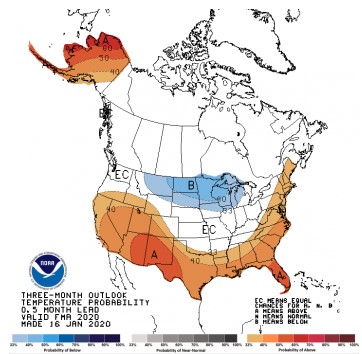Initial February temperature and precipitation outlooks from the Climate Prediction Center (CPC) indicate elevated probabilities of colder than average conditions across much of the Midwest, including Iowa (not pictured). On the precipitation side, there’s a slightly elevated signal for drier than normal conditions across the southern part of the state (not pictured). Looking forward seasonally, the initial February-March-April outlooks show slightly higher probabilities of colder and wetter conditions across northern Iowa and equal chances (EC) of above, below or near-average conditions for the rest of the state (Figures 1 and 2).

When talking about spring outlooks, we’re still one and a half months out, which can make it challenging to predict temperature and precipitation behavior. We are seeing a consistent signal trending towards elevated chances of wetter conditions across much of the Midwest with no clear signal in terms of temperatures (Figure 3). This weather outlook could change before spring arrives, but an important topic of discussion this winter has been the recent trend toward wetter falls and wetter springs. This forecast implies that we may be in for a continuation of that trend.
Despite the possible uncertainty in the outlooks, there is one certainty – soils will enter the spring still wet from the fall. Thus, any inclination toward cooler and wetter conditions increases the chances of planting delays in the spring. Producers should start thinking about possible actions to deal with delays in planting again.
Source : iastate.edu